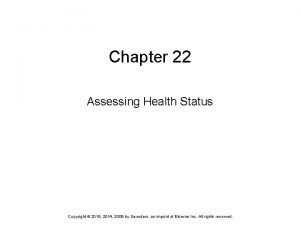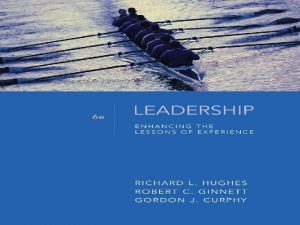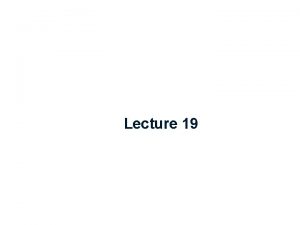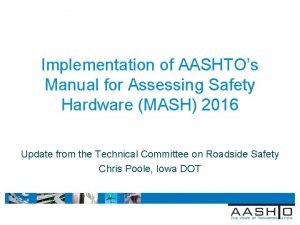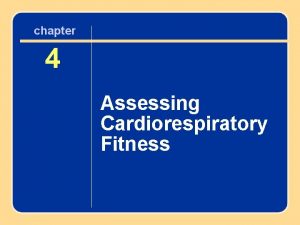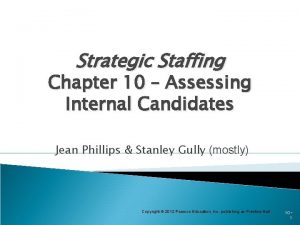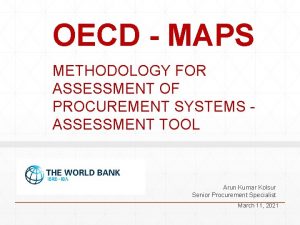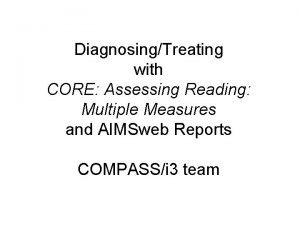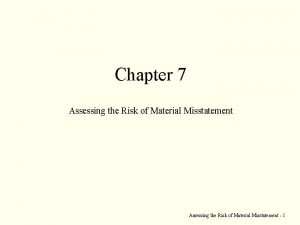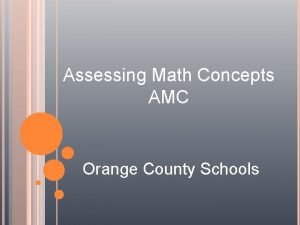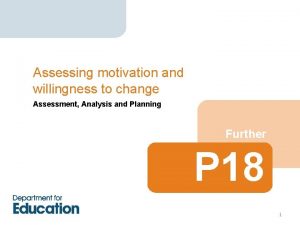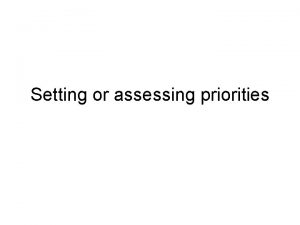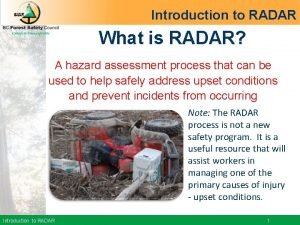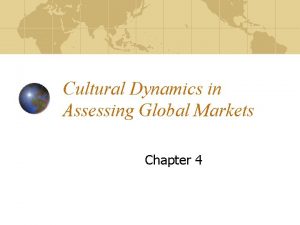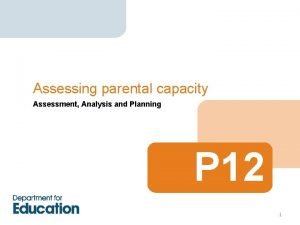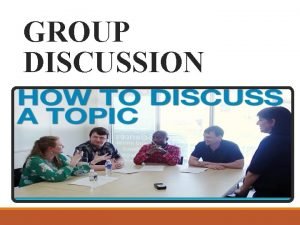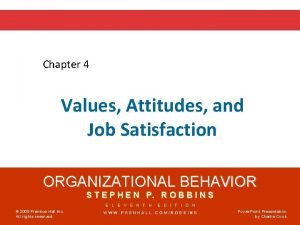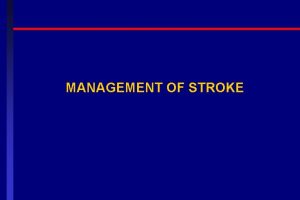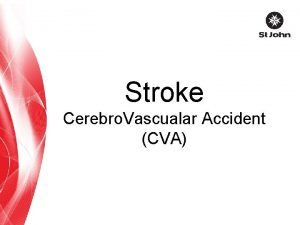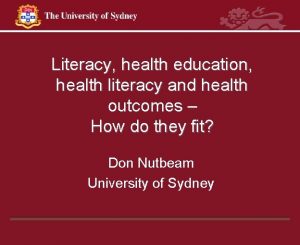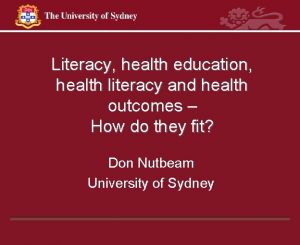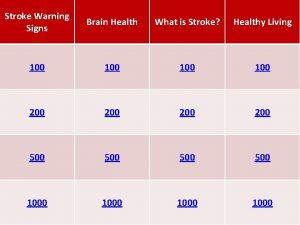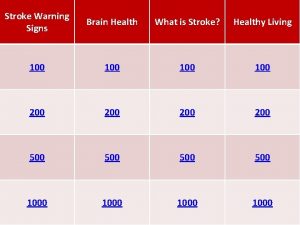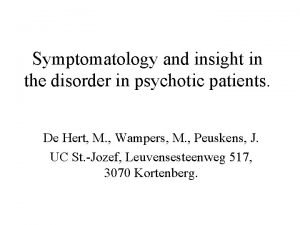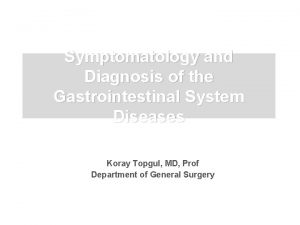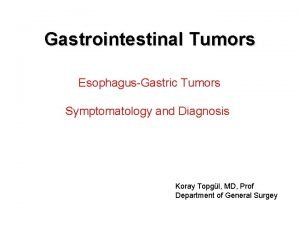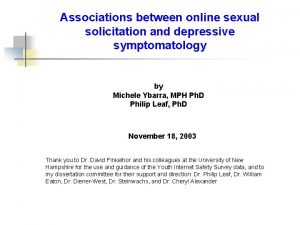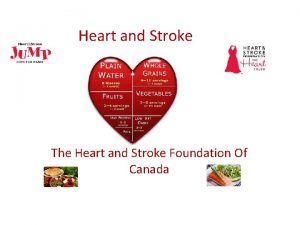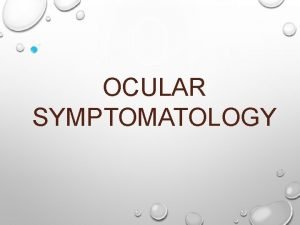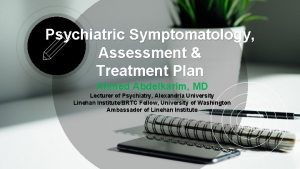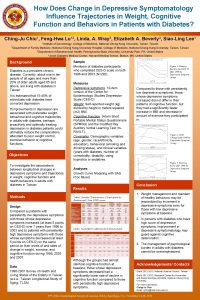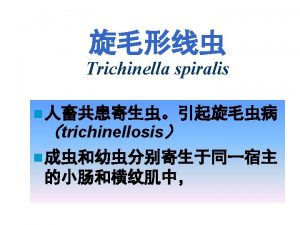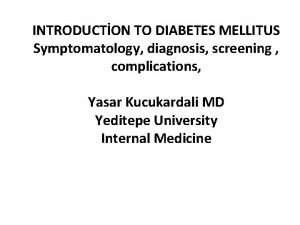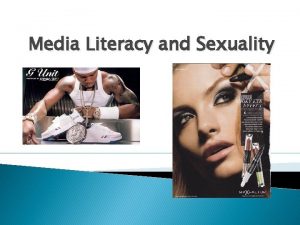1 Assessing Health Literacy and Stroke Symptomatology in


































- Slides: 34

1 Assessing Health Literacy and Stroke Symptomatology in Older Adults • • • 1 Amy K. Chesser, Ph. D, Aging Studies, Department of Public Health Sciences Wendy Dusenbury, DNP, APRN, FNP-BC, AGACNP, CNRN, ANVPBC, Assistant Professor, School of Nursing Inneke Vargas, Mc. Nair Scholar Twyla J. Hill, Ph. D, Professor of Sociology, Nicole L. Rogers, Ph. D, Department of Public Health Sciences

Study Team 2

Agenda Health Literacy Stroke Our Study 3

Health Literacy Toward Solutions Definition 4 Assessment Intervention

Health Literacy 5

What is Health Literacy? “The degree to which individuals have the capacity to obtain, process, & understand basic health information & services needed to make appropriate health decisions. ” 6 HHS, National Institutes of Health, National Library of Medicine (NLM). Health Literacy, January 1990 Through 1999. NLM Pub. 2000, vi.

Published Screening Tools 7 # Tool Year Type 1. WRAT-R 3 1965. 1995 Word recognition 2. REALM* 1991, 1993 Health word recognition 3. TOFHLA* 1995 Comprehension of health materials 4. S-TOFHLA* 1999 Comprehension of 2 health forms 5. HALS 2004 Use of print materials to accomplish health tasks 6. NVS 2005 Comprehension, numeracy interpretation of food label 7. MART 1997 Medical word recognition 8. LAD 2001 Diabetes word recognition 9. REALM-R 2003 Health word recognition 10. REALM-SF 2006 Health word recognition 11. REALM-Teen 2006 Adolescent health word recognition 12. SAHLSA 2007 Spanish word recognition and comprehension Davis et al. HARC (2010)

Health Literacy: Single Item Screener (1) How confident are you in filling out medical forms by yourself? For example insurance forms, questionnaires, and doctor’s office forms. Would you say… Response choices: • Not at all • A little • Somewhat • Quite a bit • Extremely 8

Effects of Ageing and Health Literacy The 2003 National Assessment of Adult Literacy (NAAL) estimated only 3% of older adults, 65 and older, were proficient with health literacy skills 9

Age-Related Changes and Health Literacy There are several different age-related changes that could contribute to the decrease in health literacy in older adults. • • Decline in cognitive ability Physical impairments (i. e. hearing and vision loss) Psychosocial factors Sense of shame and embarrassment 10

Health Literacy and Older Adults: The Literature Year Number of Published Articles 2000 -2005 3 publications 2006 -2010 26 publications 2011 -2015 2009: 1 book: Ruby Brougham: New directions in aging research: health and cognition 59 publications 2016 -2017 37 publications TOTAL 127 11

State of Kansas Health Literacy Rates (BRFSS 2014) 29 Health Literacy Rate % Weighted Low Health Literacy 7. 5% Moderate Health Literacy 61. 1% High Health Literacy 31. 4%

Stroke 13

Background of Stroke • Stroke is the 5 th leading cause of death in the United States • Stroke is the leading cause of disability worldwide • Approximately 800, 000 people will have a stroke this YEAR • Adults age 60 and over are at highest risk

Background Stroke: Cont. • Time sensitive treatments are available • Delayed treatment is due to failed recognition by patients, family, and general bystanders • 60% of stroke related deaths occur outside of the hospital

Types of Stroke Ischemic: A common type of stroke that happens when an artery in the brain is blocked by clot or plaque Hemorrhagic: This type of stroke happens when a blood vessel in the brain breaks or ruptures causing blood to leak out into or around the brain tissue

Transient Ischemic Attacks (TIA) • Symptoms are the same as a stroke • Symptoms resolve • Important to know that someone that experiences a TIA needs to have a stroke workup. This is a warning sign and these people will often have a stroke in the near future.


Signs of Stroke • Sudden onset of numbness or weakness of the face, arm, or leg (especially on one side of the body) • Sudden confusion, trouble speaking, or understanding • Sudden trouble seeing in one or both eyes • Sudden trouble walking, dizziness, or loss of balance • Sudden severe headache with no known cause

FAST • • Facial Droop Arm Weakness Speech difficulty (trouble speaking) Time to call 911

Health Literacy and Stroke Symptomology 21

The Problem • Approximately 795, 000 strokes occurring in the United States each year, with nearly 75 percent of all strokes occurring in those 65 years and older. • Multiple studies suggest that stroke treatment is delayed due to the failure of symptom recognition by the patient, family, or general bystanders with approximately 60% of stroke related deaths occur outside the hospital setting. • Compounding this problem is the fact that many stroke patients are still being transported by private vehicle instead of a 911 activation, further delaying treatment. 22

Methods • The purpose of our research was to provide support for a multi-disciplinary approach to stroke education and prevention. 23

Methods • Experimentally-designed knowledge and opinions pre- and post-test assessment. • The study participants included three, separate groups in three study phases: • • • 24 1) staff and team members at a community senior center, 2) older adults (age 65 and older) living at the senior center, and 3) family members or caretakers of older adults. This was an experimental design, feasibility/pilot study using a convenience sample of participants from a Midwest senior living community.

Results for Educational Session: FAST # 1 2 3 4 25 Answer Face, Accelerate, Speech, Type Fake, Arm, Slow, Time Face, Arm, Speech, Time (time to call 911) Total % 0. 00% Count 0 0. 00% 0 3. 57% 1 96. 43% 27 100% 28

Results for Educational Session: Symptomatology Knowledge 26 # Answer % Count 1 sudden numbness or weakness of the face, arm or leg, especially on one side of the body 26. 32% 25 2 Sudden confusion, trouble speaking or understanding 23. 16% 22 3 sudden trouble seeing in one or both eyes 15. 79% 15 4 Sudden trouble walking dizziness or loss of balance 18. 95% 18 5 Sudden severe headache with no known cause 15. 79% 15

Results for Educational Session: How often is health information written in a way that is easy for you to understand? 27 # Answer % Count 1 sudden numbness or weakness of the face, arm or leg, especially on one side of the body 26. 32% 25 2 Sudden confusion, trouble speaking or understanding 23. 16% 22 3 sudden trouble seeing in one or both eyes 15. 79% 15 4 Sudden trouble walking dizziness or loss of balance 18. 95% 18 5 Sudden severe headache with no known cause 15. 79% 15

Wilcoxon Signed Rank Test The nonparametric Wilcoxon Signed Rank test was used to compare the pre- and post-test values Small sample size and non-normality of the outcome variables. Only the answers of the 28 respondents who completed both the pre- and post-tests were used for the analysis.

Comparison of knowledge pre- and posttest (n=28) Category Minimum Maximum Mean S. D. knowledge of symptoms at pretest 0 5 3. 18 1. 91 knowledge of symptoms at posttest 0 5 4. 00 1. 66 knowledge of prevention at pretest 0 8 5. 46 2. 69 knowledge of prevention at posttest 0 8 6. 46 2. 62

Results • The means were statistically significantly higher at post-test for both knowledge of symptoms and of prevention factors. Comparison of knowledge of symptoms pre- and post-test: Z = -2. 373, p =. 018 Comparison of knowledge of prevention factors pre- and posttest: Z = -2. 401, p =. 016

Conclusions Health Education for knowledge levels of stroke and health literacy may be effective for this population. A larger, multi-site study is needed to confirm these results. Health professionals, patients and families are key populations for the prevention of stroke in older adults. 31

References 1. 2. 3. 4. 5. 6. 7. 8. 32 Aaby, A. , Friis, K. , Christensen, B. , Rowlands, G. , & Maindal, H. T. (2017). Health literacy is associated with health behaviour and self reported health: A large population-based study in individuals with cardiovascular disease. Eur J Prev Cardiol, 24(17), 1880 -1888. doi: 10. 1177/2047487317729538 Institute of Medicine (US) Committee on Health Literacy; Nielsen-Bohlman L, Panzer AM, Kindig DA, editors. Health Literacy: A Prescription to End Confusion. Washington (DC): National Academies Press (US); 2004. 1, Introduction. Available from: https: //www. ncbi. nlm. nih. gov/books/NBK 216033/ Kerns, J. M. , Heidmann, D. , Petty, M. , & Prabhakaran, S. (2011). Optimizing public health strategies for stroke education: need for a controlled trial. Am J Ther, 18(1), 81 -90. doi: 10. 1097/MJT. 0 b 013 e 3181 e 123 cd “National Assessment of Adult Literacy (NAAL). ” National Center for Education Statistics (NCES) Home Page, a Part of the U. S. Department of Education, nces. ed. gov/naal/health_results. asp. “Stroke. ” Centers for Disease Control and Prevention, 16 Feb. 2018, www. cdc. gov/stroke/index. htm.

What do you think? 33

Contact: Amy K. Chesser ………………………………. 34 Amy K. Chesser, Ph. D, Associate Professor Aging Studies, Department of Public Health Sciences College of Health Professions ……………………… Office: Ahlberg Hall, Room 323 Phone: 978 -3145 Email: amy. chesser@wichita. edu
 Symptomatology
Symptomatology Anterior stroke vs posterior stroke
Anterior stroke vs posterior stroke Assessing health status chapter 22
Assessing health status chapter 22 Venn diagram media information and technology literacy
Venn diagram media information and technology literacy M.i.l subject
M.i.l subject Limitations of people as media
Limitations of people as media Cyber literacy for the digital age
Cyber literacy for the digital age Ways to address grammar in the writing classroom ppt
Ways to address grammar in the writing classroom ppt Domains of ppst and explanation
Domains of ppst and explanation Informal reading inventory strengths and weaknesses
Informal reading inventory strengths and weaknesses Assessing a new venture's financial strength and viability
Assessing a new venture's financial strength and viability Assessing leadership and measuring its effects
Assessing leadership and measuring its effects Module 4 topic 1 assessing and managing risk
Module 4 topic 1 assessing and managing risk Module 4 topic 1 assessing and managing risk
Module 4 topic 1 assessing and managing risk Btec sport unit 3
Btec sport unit 3 Unit 18 assessing children's development support needs p1
Unit 18 assessing children's development support needs p1 Task analysis in hrd
Task analysis in hrd Manual for assessing safety hardware
Manual for assessing safety hardware Cultural dynamics in assessing global markets
Cultural dynamics in assessing global markets Assessing cardiorespiratory fitness
Assessing cardiorespiratory fitness A nine box matrix requires assessing employees on ________.
A nine box matrix requires assessing employees on ________. Methodology for assessing procurement systems
Methodology for assessing procurement systems Core graded high-frequency word survey
Core graded high-frequency word survey Ar = ir x cr x dr
Ar = ir x cr x dr Amc math assessment
Amc math assessment Assessing motivation to change
Assessing motivation to change Assessing opportunity cost involves
Assessing opportunity cost involves Assessing the situation
Assessing the situation Cultural dynamics in assessing global markets
Cultural dynamics in assessing global markets Assessing value for money
Assessing value for money Assessing parental capacity
Assessing parental capacity Group discussion images
Group discussion images Values attitudes and job satisfaction
Values attitudes and job satisfaction Cultural dynamics in assessing global markets
Cultural dynamics in assessing global markets Assessing the internal environment of the firm
Assessing the internal environment of the firm


